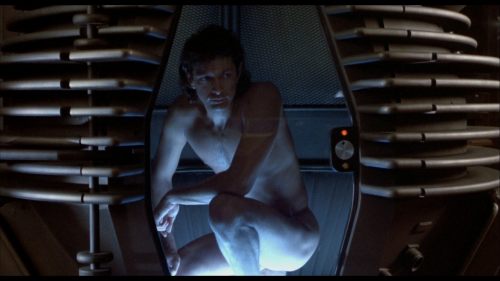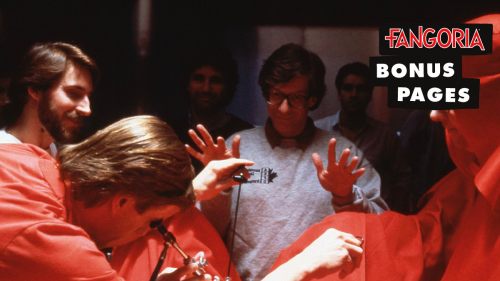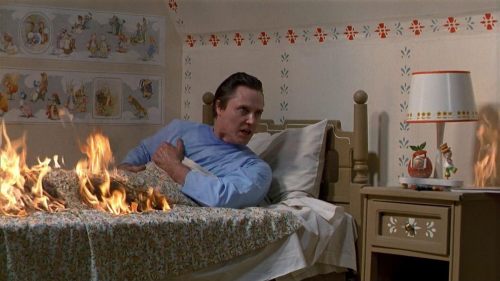Our Daily Trailer: M. BUTTERFLY
The horror directors of the '70s and '80s were an elite group, helping to create a new golden age of terror, and riding the auteur theory to a previously nonexistent place of acclaim for the genre. They changed the game while cranking out instant classics, fueled by passion and youth. Though the roster changed here and there - sometimes it would include Brian De Palma, sometimes it would include Joe Dante, or John Landis, or Tobe Hooper - the core group always seemed to include George A Romero, John Carpenter and David Cronenberg. It was an exciting time to watch this New Guard take over from the Castles and the Cormans, forging a new path.
Then they got old, and one by one, the fires inside them seemed to go out, leaving one man standing. Romero was regional, a blue-collar indie guy, resisting the call to Hollywood and cranking out angry little epics from his Pittsburgh home base. When he got in bed with the studios in the '90s, he claimed, Romero made more money NOT making movies in Hollywood than he ever had making them in Pittsburgh, writing draft after draft of unrealized projects and languishing in turnaround. When he hightailed it to Canada in 2005 for Land of the Dead, he stayed there, making in a four-year span as many zombie movies as he’d made in the previous 37. Carpenter was a fan of the old-school, but his synth-driven takes on John Ford and Howard Hawks territory nevertheless coalesced into his own distinctive style. His '90s output has its fans, but the early fire seemed to go out of the director, who became vocally content to kick back and play video games. Tobe Hooper, whose Texas Chain Saw Massacre was arguably the most terrifying film any of them would ever make, released three pictures between 1985 and 1986 that all seemed to come from a different filmmaker, and his second best film carries the whispered stigma of having been directed by someone else. But Cronenberg was always doing his own thing, happy to sit on interview panels with these guys but simultaneously always off on his own, developing a consistent set of themes across a body of work that never felt 100% at home within the confines of horror. More than any of his peers, it must be said, Cronenberg was creating something brand new. “Romero-ish” isn’t really a thing these days, and “Carpenter-esque” never really became part of the lexicon, but today “Cronenbergian” has a very specific meaning.
I’ve spent thousands of words on the site exploring just what that meaning is (here, here and here. And here), but what’s not up for debate about David Cronenberg is that he’s managed to not only endure but to thrive, long after his peers have wilted, dried up and called it a day. And he did it by moving out of horror, while keeping his themes and heady ideas intact. With 1988’s Dead Ringers and 1991’s Naked Lunch the director took his first steps away from horror, though he retained in those films the aesthetics and wet FX from the genre. But 1993’s M. Butterfly truly marks the beginning of what one of BAD’s commenters once called “NPR-Approved Cronenberg.”
M. Butterfly is a first in a lot of ways for Cronenberg. Not only is it his first departure from FX-heavy productions, but it marks his first project filmed outside his native Canada. Cronenberg takes full advantage, staging scenes in Hungary, Paris and at the Great Wall Of China. Some things are more familiar: he’s reunited with Dead Ringers’ Jeremy Irons and is once again exploring questions of identity. And he's adapting another true story, this time via David Henry Hwang’s play about René Gallimard (Irons), a French diplomat falling in love with a beautiful opera singer (John Lone) who turns out to be a man - and a Chinese spy, deceiving René in the name of espionage (or so we think).
The film got some lukewarm reviews upon release, with critics comparing it unfavorably to the previous year’s The Crying Game due to some superficial (and obvious) narrative overlap. Casting John Lone as Song Liling, instead of going with a more sexually ambiguous performer, was a target of derision by critics: how could Irons’ character not know he was making love to a man? What critics didn’t realize is that the very question - “how could he not know?" - was in fact Cronenberg’s point. It was an exploration, not a rhetorical question.
And who'd have imagined that cold, clinical Cronenberg could make a relationship so alien to most of us feel so relatable? "The days I spent with you were the only days I ever truly existed," Song tells René. As insane as M. Butterfly's love story gets, we’ve all been there.



